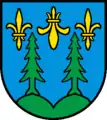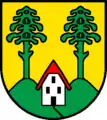Mount (heraldry)
In heraldry, a mount (also mountain, hill, hillock) is a representation of a hill or mountain as a curved terrace in base.[1] When the mount is included in the lower part of the shield, it may be considered an ordinary rather than a charge.
A trimount, also described as a mount mounted, or shapournet shapourned, is a representation of a mount with three tops.[2] For mounts with more than three tops, the number of tops is blazoned as coupeaux (e.g. a mount with six coupeaux).
The trimount (in German, Dreiberg) can be found in all heraldic traditions (Gallo-British, German-Nordic and Latin), but it is especially common in Switzerland.[3]
A design of six hills (Sechsberg) can also be found in Swiss and Italian heraldry. In medieval German heraldry, mounts could have ten or more tops.[4] Mounts with more than three tops are blazoned as a mount of N coupeaux, e.g. German Sechsberg would be a mount of six coupeaux, German Zehnberg as a mount of ten coupeaux.[3] A mount with more than six tops can also be blazoned as Schroffen in German heraldry.
Terrace in base curved
A terrace in base curved is blazoned mount, hill or hillock when represented in vert; sometimes as a mount vert for clarity. Sometines, a terrace in base curved may be blazoned as mount even when not tinctured vert. This is mostly found in cases where the base represents a hill for one or several of the charges in the coat of arms. Classification either as an ordinary or, in many cases, as a charge, is a matter of interpretation.


.svg.png.webp)
 Altafulla (Or, a mount gules surmounted by a leaf vert)
Altafulla (Or, a mount gules surmounted by a leaf vert)
Double mount
Trimount
The coats of arms of Hungary and Slovakia depict a trimount with a double cross, first used in the seal of Stephen V of Hungary (r. 1270–1272). At first, it was only a small element at the bottom of the coat of arms, later it became regular heraldic figure. Originally it represented biblical Golgota.[5][6][7] Modern day Slovak interpretation is that it represents three mountain ranges of the Kingdom of Hungary: the Tatra, Fatra, and Mátra.[8][9][10]
 Seal of Stephen V of Hungary (c. 1270), coat of arms of Hungary
Seal of Stephen V of Hungary (c. 1270), coat of arms of Hungary Seal of Wenceslaus III of Bohemia (c. 1301), coat of arms of Slovakia
Seal of Wenceslaus III of Bohemia (c. 1301), coat of arms of Slovakia
 Hennenberg (Zurich armorial)
Hennenberg (Zurich armorial)

The representation of three pointed mountains (not a heraldic trimount) in the 1991 coat of arms of Slovenia symbolises Triglav, the highest mountain in Slovenia.
Mount of four coupeaux
 Zurich armorial
Zurich armorial Helfenstein (Zurich armorial)
Helfenstein (Zurich armorial)
Mount of five coupeaux
 Freundsberg (Frontsperg, Frundsberg), 16th century
Freundsberg (Frontsperg, Frundsberg), 16th century


Mount of six coupeaux
 Grünenberg (15th century)
Grünenberg (15th century) Freundsberg (Fronsberg, Frundsberg)
Freundsberg (Fronsberg, Frundsberg)
_Wappen.svg.png.webp)



Mount of ten coupeaux
 Grünenberg (Zürich armorial)
Grünenberg (Zürich armorial)
Mount of twelve coupeaux
References
| Wikimedia Commons has media related to Terraces in base curved. |
| Wikimedia Commons has media related to Mountains in heraldry. |
| Wikimedia Commons has media related to Hills in heraldry. |
| Wikimedia Commons has media related to Triple mountains in heraldry. |
- "Armorial Gold Heraldry Symbolism Library". Armorial Gold. Retrieved 30 June 2013.
- "Mount" in: William Berry, Encyclopaedia Heraldica, Or Complete Dictionary of Heraldry (1828).
- The Coat of Arms, Volume 3, Issue 17, Heraldry Society, 1966, 36f.
- Seals of the Salenstein coat of arms show a mount of twelve tops in 1264, and even one with twenty-eight in 1297.
Ernst Herdi: Die Schenken und die Dienstmannen von Salenstein In: Thurgauische Beiträge zur vaterländischen Geschichte. Vol. 79. Year: 1943. pp 47 ff. - http://www.heraldica.szm.com/stranky/NNNew/Ndvojkriz.htm
- https://matica.sk/byzantske-korene-statneho-znaku-sr/
- https://plus.sme.sk/c/20456071/ako-vznikal-statny-znak-pozrite-si-doteraz-skryte-socialisticke-navrhy.html
- https://archiv.vlada.gov.sk/old.uv/7889/statny-znak.html
- Betsy Dru Tecco: How to Draw Hungary's Sights and Symbols, The Rosen Publishing Group, New York, 2005
- https://plus.sme.sk/c/20456071/ako-vznikal-statny-znak-pozrite-si-doteraz-skryte-socialisticke-navrhy.html


.svg.png.webp)